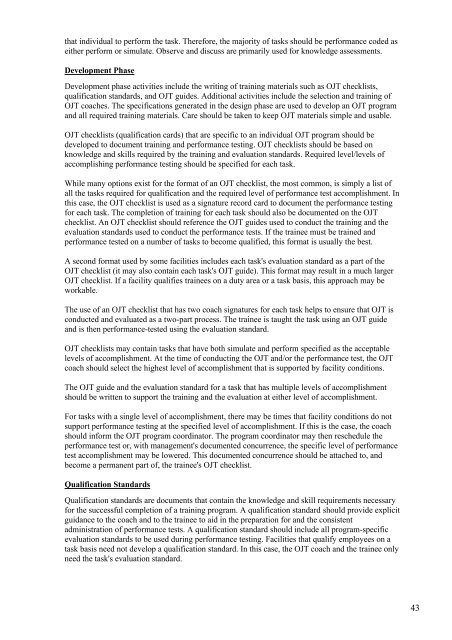How to Perform On-the-job Training - Dean Amory
According to The Encyclopedia of Business, ©2000 Gale Cengage, On-the-job training is by far the predominant form of job training. Studies also indicate that it is the most effective form of job training. Yet, it also represents a significant investment considering that roughly 30% of a new worker's time is spent in on-the-job training during the first 90 days of employment, that productivity of experienced workers assigned to train new workers may decrease during the training period, and that new workers may make expensive mistakes. Both companies and workers therefore profit largely from the presence of simple, but complete trainee and trainer guides that allow for executing OJT in a structured way. “How to perform on-the-job training”, has the information, techniques and tips that will allow you to implement a professional OJT training program. The book also includes all the tools, documents and checklists necessary for setting up a qualitative and efficient skills training program for OJT coaches
According to The Encyclopedia of Business, ©2000 Gale Cengage, On-the-job training is by far the predominant form of job training. Studies also indicate that it is the most effective form of job training. Yet, it also represents a significant investment considering that roughly 30% of a new worker's time is spent in on-the-job training during the first 90 days of employment, that productivity of experienced workers assigned to train new workers may decrease during the training period, and that new workers may make expensive mistakes.
Both companies and workers therefore profit largely from the presence of simple, but complete trainee and trainer guides that allow for executing OJT in a structured way.
“How to perform on-the-job training”, has the information, techniques and tips that will allow you to implement a professional OJT training program. The book also includes all the tools, documents and checklists necessary for setting up a qualitative and efficient skills training program for OJT coaches
Create successful ePaper yourself
Turn your PDF publications into a flip-book with our unique Google optimized e-Paper software.
that individual <strong>to</strong> perform <strong>the</strong> task. Therefore, <strong>the</strong> majority of tasks should be performance coded as<br />
ei<strong>the</strong>r perform or simulate. Observe and discuss are primarily used for knowledge assessments.<br />
Development Phase<br />
Development phase activities include <strong>the</strong> writing of training materials such as OJT checklists,<br />
qualification standards, and OJT guides. Additional activities include <strong>the</strong> selection and training of<br />
OJT coaches. The specifications generated in <strong>the</strong> design phase are used <strong>to</strong> develop an OJT program<br />
and all required training materials. Care should be taken <strong>to</strong> keep OJT materials simple and usable.<br />
OJT checklists (qualification cards) that are specific <strong>to</strong> an individual OJT program should be<br />
developed <strong>to</strong> document training and performance testing. OJT checklists should be based on<br />
knowledge and skills required by <strong>the</strong> training and evaluation standards. Required level/levels of<br />
accomplishing performance testing should be specified for each task.<br />
While many options exist for <strong>the</strong> format of an OJT checklist, <strong>the</strong> most common, is simply a list of<br />
all <strong>the</strong> tasks required for qualification and <strong>the</strong> required level of performance test accomplishment. In<br />
this case, <strong>the</strong> OJT checklist is used as a signature record card <strong>to</strong> document <strong>the</strong> performance testing<br />
for each task. The completion of training for each task should also be documented on <strong>the</strong> OJT<br />
checklist. An OJT checklist should reference <strong>the</strong> OJT guides used <strong>to</strong> conduct <strong>the</strong> training and <strong>the</strong><br />
evaluation standards used <strong>to</strong> conduct <strong>the</strong> performance tests. If <strong>the</strong> trainee must be trained and<br />
performance tested on a number of tasks <strong>to</strong> become qualified, this format is usually <strong>the</strong> best.<br />
A second format used by some facilities includes each task's evaluation standard as a part of <strong>the</strong><br />
OJT checklist (it may also contain each task's OJT guide). This format may result in a much larger<br />
OJT checklist. If a facility qualifies trainees on a duty area or a task basis, this approach may be<br />
workable.<br />
The use of an OJT checklist that has two coach signatures for each task helps <strong>to</strong> ensure that OJT is<br />
conducted and evaluated as a two-part process. The trainee is taught <strong>the</strong> task using an OJT guide<br />
and is <strong>the</strong>n performance-tested using <strong>the</strong> evaluation standard.<br />
OJT checklists may contain tasks that have both simulate and perform specified as <strong>the</strong> acceptable<br />
levels of accomplishment. At <strong>the</strong> time of conducting <strong>the</strong> OJT and/or <strong>the</strong> performance test, <strong>the</strong> OJT<br />
coach should select <strong>the</strong> highest level of accomplishment that is supported by facility conditions.<br />
The OJT guide and <strong>the</strong> evaluation standard for a task that has multiple levels of accomplishment<br />
should be written <strong>to</strong> support <strong>the</strong> training and <strong>the</strong> evaluation at ei<strong>the</strong>r level of accomplishment.<br />
For tasks with a single level of accomplishment, <strong>the</strong>re may be times that facility conditions do not<br />
support performance testing at <strong>the</strong> specified level of accomplishment. If this is <strong>the</strong> case, <strong>the</strong> coach<br />
should inform <strong>the</strong> OJT program coordina<strong>to</strong>r. The program coordina<strong>to</strong>r may <strong>the</strong>n reschedule <strong>the</strong><br />
performance test or, with management's documented concurrence, <strong>the</strong> specific level of performance<br />
test accomplishment may be lowered. This documented concurrence should be attached <strong>to</strong>, and<br />
become a permanent part of, <strong>the</strong> trainee's OJT checklist.<br />
Qualification Standards<br />
Qualification standards are documents that contain <strong>the</strong> knowledge and skill requirements necessary<br />
for <strong>the</strong> successful completion of a training program. A qualification standard should provide explicit<br />
guidance <strong>to</strong> <strong>the</strong> coach and <strong>to</strong> <strong>the</strong> trainee <strong>to</strong> aid in <strong>the</strong> preparation for and <strong>the</strong> consistent<br />
administration of performance tests. A qualification standard should include all program-specific<br />
evaluation standards <strong>to</strong> be used during performance testing. Facilities that qualify employees on a<br />
task basis need not develop a qualification standard. In this case, <strong>the</strong> OJT coach and <strong>the</strong> trainee only<br />
need <strong>the</strong> task's evaluation standard.<br />
43


















